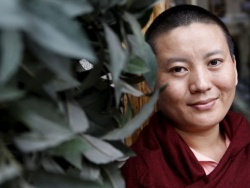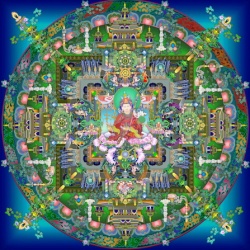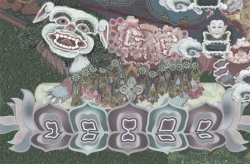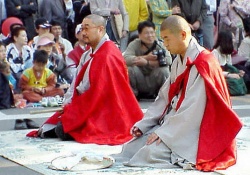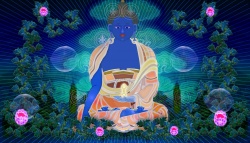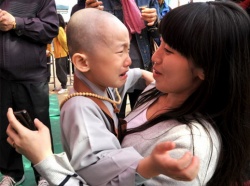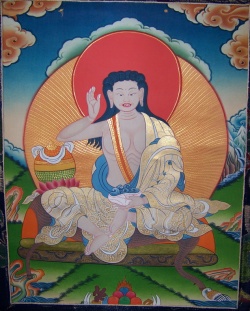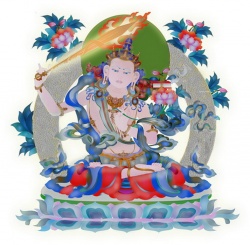The Jhanas and the Brahma Viharas
by Lloyd Burton
[This is a condensation of some talks, practice instructions, and guided meditations I offered at a retreat led by Leigh Brasington, June-July, 2003, in Chupadero, New Mexico. My enduring gratitude to Leigh for his support, guidance, and inspiration. Lloyd Burton]
In the science of ecology, consociation means two species of plants growing in close proximity to each other, each helping to sustain the other’s growth and development. In the landscapes of the American Southwest, examples include the giant Saguaro cactus and the Palo Verde tree of the Sonoran Desert, and the pion pine and juniper trees of the Colorado Plateau.
In the teachings of the Buddha as recorded in the suttas of the Pali Canon, the same is true of the Jhanas (meditative absorptions) and the Brahma Viharas (“divine abodes”, or “four immeasurables”). Whenever he discussed either of these forms of tranquility practice in any detail, it was often in fairly close proximity to some emphasis on the other. Mirroring the Buddha’s original approach, most of the meditation teachers who have openly offered training in Jhana practice in our times have also presented the Jhanas and the Brahma Viharas as companion practices (eg., Ayya Khema, Who Is My Self? [1997]; and Visible Here and Now [2000]).
Why is this so? What is the nature of this spiritual consociation, and why is it important? Based on my own study and practice experience, I think it is because there are several ways that the Jhanas and the Brahma Viharas can facilitate, strengthen, and support each other. This essay begins with inquiry into some of the mutually beneficial connections between these two realms of practice, then offers some words and phrases to use in practicing the Brahma Viharas that are drawn from the imagery the Buddha used in teaching the Jhanas, as a way of showing how we can cultivate these connections in our personal practice experience.
The Jhanas: Approach, Avoidance, and Ambivalence
The Pali Canon and its commentaries are replete with references to the Buddha’s teachings on the Jhanas. Again and again, he refers to these alternative states of consciousness as manifestations of progressively deeper levels of concentration. And although he taught Jhana practice mostly as a way to facilitate deep insights when the meditator moves from Samatha to Vipassana practice, the Jhanas also provided the means by which the Buddha consciously took leave of his followers at the time of his parinirvana.
Yet the majority of Eastern and Western meditation teachers who train students in practices from the Theravada tradition seem distinctly ambivalent on the question of whether the Jhanas should be openly taught at meditation retreats (as distinguished from private tutorial training for students doing long-term intensive practice), or even whether they should be freely discussed at all. The reason many of them give for this ambivalence is that certain kinds of difficulties can arise when undertaking Jhana practice that potentially outweigh the benefits of learning it (e.g., Ajahn Chah, Food For the Heart, 2002). And it is for this very reason that it is so important that if the Jhanas are to be taught and practiced, in keeping with the tradition established by the Buddha when he first taught them, this should happen in companionship with – in consociation with – the Brahma Viharas. As well, it also necessary to remember that both of these tranquility practices were also taught by the Buddha in consociation with Insight Meditation, because of their same mutually beneficial character.
Based on my own studies of the literature, received teachings, and practice experience, it seems that four different kinds of difficulties can arise when learning and practicing the Jhanas. For some, these are minor hindrances that pass with time, practice, and wise counsel; but for others (and to some extent this is the voice of personal experience) these problems can be a substantial source of dukkha, needing as much care and attention (and patience, and practice, and wise counsel) as does working with any other form of suffering. And as with any other manifestation of suffering, they all have as their root cause some form of craving and clinging. In describing each of these four below, I have given them Pali names, since in my experience they do indeed roughly correspond to different stages in learning the practice of Jhana, some of which go by those names. This point seems worth noting, since it represents my own interpretation rather than a literal rendering of what the Pali Canon has to say on the subject.
The first of these four consists of feelings of frustration, disappointment, and doubt that can arise from unsuccessful efforts to establish access concentration and entry into Jhanic states – an experience that can be described as vitaka (applied thinking) dukkha . Having set an intention or expectation that you are about to be transported into some mystical, magical state, and then following whatever instructions you’ve been given or have read on how to achieve access, if nothing much seems to be happening, a sense of failure and dashed expectations can move like a fog bank over your sitting experience.
If you have had some success in gaining entry into any of the rupa Jhanas (“fine material absorptions” – experienced as being grounded in the plane of physical existence), a second form of difficulty can be termed vicara dukkha (sustained thinking), which consists of craving the attainment of higher Jhanic states while clinging to the experience of repeated entry into the lower ones that have already been accessed.
A third form of difficulty can be thought of as samatha dukkha (tranquility). Having learned to routinely access the rupa Jhanas and perhaps some of the arupa (non-material) ones as well, and having discovered that they can indeed temporarily suppress the five classic obstacles to concentration, there can be a tendency to use Jhanic states as a place to run and hide, rather than as preparation for opening the mind to the insights that can occur when moving from Jhana to Vipassana practice. The temptation is to use these powerfully serene, extra-rational states as a way to avoid facing whatever suffering may be arising in your life, rather than looking at it more carefully and insightfully. And while “getting hooked” on self-induced tranquility certainly causes less wear and tear on the heart, lungs, and liver than some other forms of dependency, it is still a form of clinging that eventually needs to be relinquished.
The fourth form of difficulty might be termed nibbana dukkha – the sense that once access to and mastery of all the Jhanas has been achieved, so has the end of all suffering. In describing this misconceived conviction that one has come to the end of the path, the Buddha noted that one of its qualities is a very subtle but persistent clinging to the status of being enlightened. In his view, to say “I am without clinging” is a problem, since it implies an “I” who is not clinging (MN 102.24). And unfortunately, many of those who have inhabited this mindstate for any period of time and have been willing to speak of their experience have eventually returned to report that – sadly but unsurprisingly – it didn’t last (see, for instance, Jack Kornfield, After the Ecstasy, the Laundry, 2000).
Of these four forms of dissatisfaction that can manifest when working with the Jhanas – vitaka dukkha, vicara dukkha, samatha dukkha, and nibbana dukkha – the Brahma Viharas are especially useful in addressing the first two, which also tend to be associated more with the beginning stages of experience with Jhana practice, and thus also with the rupa Jhanas. The most useful remedy for problems associated with samatha and nibbana dukkha is actually the practice of Vipassana itself, perhaps starting a period of sitting meditation by setting the intention to focus on intention – that is, beginning with reflective inquiry on why one is doing Jhana practice in the first place. This can be done either instead of or before volitionally (rather than reflexively) entering a jhanic state.
But a talk on Insight practice as a way to better understand and work with Jhana-related samatha and nibbana dukkha will have to wait for another time. The focus here is on the Brahma Viharas as a way to work with the mindstates of craving and clinging that can be associated with efforts to gain entry into the Jhanas and to move through them.
The Brahma Viharas
Usually translated as “divine abodes” or “divine abidings”, the very name of this practice form can confuse Western practitioners. It tends to conjure up Christian and Islamic visions of an other-worldly realm worshipers should aspire to and that their spirits might ascend to at some future time, if they play their spiritual cards right on the physical plane in the here and now (or as Woody Guthrie put it in a song title, “There’ll Be Pie in the Sky When You Die”).
The name originated from one of the contexts in which the Buddha taught the practice (MN 99). The occasion was an encounter between the Buddha and a student named Subha – who at the time of their meeting was a devout practitioner of Brahmanism, the dominant religious tradition of the Buddha’s time and culture. Like Christianity and Islam, Brahmanism posited both an external Supreme Being (Brahma) and an eternal soul (Atman). The goal of all spiritual practice was to purify and perfect Atman to the point where it could come into the presence of and into communion with Brahma.
Subha had heard that, rather than repeating various rites and rituals in the hope of unification with Brahma and deliverance from the physical plane at the end of life, the Buddha had discovered a means of directly accessing Brahmanic realms – of entering into the “heavenly abodes”, into the presence of Brahma – in the here and now. So naturally enough, the student’s main question in this legendary encounter was how he too could access this fast track to paradise.
The question presented the Buddha with an interesting choice. For while he did not dispute the existence of beneficent spirit beings inhabiting other realms of existence parallel to ours on the physical plane, he also did not teach the existence of either one supreme spiritual being, or of a permanent and abiding self. In fact, the term he used in this latter teaching was Anatman – the opposite of self, or “not self” (Pali, Anatta). So one possible teaching response would have been for the Buddha to simply inform Subha that his Brahmanic beliefs were based on incorect assumptions.
Rather than dismiss Subha’s theology out of hand, however, what the Buddha did was to generate an alternative spiritual world view using concepts and ideas already familiar to the young student (MN 99.24). There are actually four such heavenly realms, he told Subha. But instead of being at some external location accessed by the grace of an external deity, the path to these realms in effect leads inward rather than outward, for they are actually states of mind. And deliverance of the mind into these states occurs through the meditator’s own intentions and efforts, through a process of concentration-based internal transformation. Further (he said in other contexts), once these states of mind have been discovered and developed within, they naturally radiate outward, infusing not only the meditators’ state of consciousness with the view from these newfound “windows on the world”, but pervading their environment and all sentient beings around them as well.
The best known of these four is Metta (usually translated as “lovingkindness” or “spiritual friendliness”), since in the Metta Sutta the Buddha provided a detailed description of its qualities and equally detailed instructions on how to evoke them. The other three are Mudita (translated in the Samyutta Nikaya as “altruistic joy” – resonance with the happiness in oneself and in others); Karuna (compassion – resonance with the suffering in oneself and others); and Upekkha (equanimity - resonance with the stillness, silence, and peacefulness in oneself and others). In addition to being the name of one of the four, contemporary teachers sometimes use the term Metta as a collective description of all four, based on the understanding that each is suffused with the same open-hearted intention to share these states of consciousness with all sentient beings.
Relating the Brahma Viharas to the Jhanas in Practice
Among Eastern and Western teachers who focus on the practice of Metta (used here as a collective term for the Brahma Viharas), there seems to be quite a variety of recommended practice approaches. Some simply advise recitation of the Metta Sutta itself, while others encourage students to discover words and phrases for themselves that seem to embody the qualities of heart-mind it is the purpose of this practice to evoke and cultivate (the two approaches are of course not mutually exclusive).
The words and phrases suggested here for doing Brahma Vihara practice have been chosen for the two purposes of showing how they can be used to work with difficulties in the early stages of Jhana practice, and how they can also be used as an alternative means of experiencing many of the same benefits that Jhana practice has to offer. There are two ways that the Brahma Vihara practice suggested here can aid in working with the Jhanas. The first is as a means of generating access concentration for entry into the rupa Jhanas, and the second (particularly Karuna practice) is as a way to open to and more deeply understand the kind of suffering occasioned by attachment to spiritual attainment. (The Buddha also taught the Brahma Viharas as a means of directly accessing the arupa Jhanas [SN V.46], but that subject too must wait for another time).
Regarding its application to developing access concentration, one virtue of Brahma Vihara practice is that if you are doing it only for the utilitarian purpose of accessing the Jhanas, it won’t work. But if your intention is simply to cultivate these heart-mind qualities for their own sake – for the benefits they can confer on their own to oneself and to others – this very sincerity of intention without expectation can help make possible the kind of undistracted concentration that facilitates access to the Jhanas.
Moreover, the Brahma Viharas are not a consolation prize. Whether or not a transition occurs from cultivation of a Brahma Vihara to a Jhanic state, the change in consciousness that Brahma Vihara practice brings about over time is cumulative, providing many of the same tranquility-based benefits as the Jhanas. And finally, everyone who does Buddhist meditation practice has the capacity to cultivate the Brahma Viharas, while most teachers knowledgeable of the Jhanas (e.g., Ajahn Chah, id.) also acknowledge that aptitude for their practice varies among students – just as some students may seem to have innate abilities in the realm of music or fine arts, but even if given the formula and dimensions could not calculate the volume of a sphere if their lives depended on it.
In addition to incorporating the imagery the Buddha used to describe various Jhanic states, the words and phrases suggested here for doing Brahma Vihara practice combine that imagery with a focus on breathing, and for three reasons. First, the combination of imagery and breathing can enhance concentration. Second, the combination provides a way to experience each of the Brahma Viharas throughout the body, rather than solely as a recitation of words by the discursive mind.
Third, there are some common misconceptions concerning Brahma Vihara bhavana (cultivation) that a focus on the breathing can help to offset. One misunderstanding is that saying these words and phrases essentially consists of wishing that things were different than they are, rather than accepting them as they are. If you are not feeling particularly compassionate, or joyous, or peaceful, or open-hearted – and may in fact be experiencing just their opposites – it can feel inauthentic, artificial, and perhaps even untruthful to repeat these phrases.
However, it is important to remember that the Buddha taught again and again (literally dozens of times throughout the suttas) that the Brahma Viharas are naturally occurring qualities that can arise within one’s own state of being if given the opportunity. As the Dalai Lama has observed, they are our “spiritual birthright”. They are potentially existent seeds enfolded in our consciousness from the time of our conception (along with some less wholesome ones), and need only the same kind of care we use in tending a garden to fully manifest in our state of being. Whether or not you find yourself feeling more compassionate, happy, peaceful, or open-hearted as you repeat these phrases and embody them with the breath does not matter. Just as vegetables do not leap fully matured from your garden the moment you begin tending the seeds that will become the plants, we do not know when our cumulative efforts in this form of heart-mind cultivation will begin to yield their harvest.
A focus on the breathing in combination with using words and phrases that emphasize opening to something already within helps us to remember this all-important teaching. With each breath and each repetition of these phrases, we are digging into the soil of our consciousness, allowing in the moisture, nutrients, and air that will awaken these seeds and bring them – steadily and at their own pace – to fruition. We do our part as gardeners of the little plot of consciousness entrusted to us, then surrender to the unfolding of this very natural process.
Some students doing this practice have also reported that they find it much easier to direct well-wishing towards others than to themselves. They have felt a surprising amount of resistance to working first on the cultivation of these heart-mind qualities for themselves before radiating them outward – based on the view that to focus on oneself first is yet another manifestation of Western self-absorption and self-reification.
But the real reason for this resistance may have far deeper roots. For to admit that we wish to experience these qualities of the heart-mind (compassion, joy, equanimity, lovingkindess) is a gesture of vulnerability – of surrender to deeply felt spiritual needs. Seen in this light, the self-imposed isolation and even self-condemnation comprising resistance to doing Brahma Vihara practice can be understood as a sadly misguided effort at self-protection. For to open to the possibility of accepting love (including love offered from oneself to oneself) is to risk being denied it. If we are to live fully, however, it is a risk we must eventually be willing to take.
This is why the following words and phrases begin with a little more emphasis than some other versions on the cultivation of these qualities within oneself before offering them in an ever-expanding sphere to those around you. In some traditions the Brahma Vihara practice begins with a focus on oneself, while in others it is less emphasized. It is emphasized in the words and phrases below because of the context in which they are being taught – as a way to explore and address certain forms of mental suffering that can be associated with Jhana practice.
Like everything else, it is a question of balance. If Insight practice has revealed a mind plagued by tight contraction, envy, agitation, or aversion (whether for oneself or others), it may be entirely appropriate to do Brahma Vihara practice mostly for oneself, as a way of expanding the space within which these difficult emotions are arising, and of providing oneself with the inner resources for attending to these afflictive emotions. If such mental suffering is not in evidence, then the emphasis will naturally be more on sharing the fruits of Brahma Vihara bhavana with those around you and with all sentient beings. The difference is one of balance rather than of intention. In my experience, the better grounded these qualities are within, the more stable the basis for expanding them outward. But the intention remains the welfare of all sentient beings, while neither reifying nor ignoring the particular sentient being we happen to be this time around . . .
Suggested Words and Phrases
These are practice instructions for each of the four Brahma Viharas, with the actual suggested words and phrases in italics. Following the phrases and instructions for each Brahma Vihara, they are all assembled into one guided meditation, that also incorporates some text from the Metta Sutta.
Karuna (Compassion). To evoke a genuine sense of compassion for the experience of suffering in oneself and others, it is helpful to look a little more deeply into what that word connotes in the English language. First, to fully open to the physical and/or mental suffering in oneself and others requires a certain amount of courage, since the conditioned response to suffering in any form is to avoid acknowledging it, to contract away from it, and to do everything possible to escape it. Second, a compassionate response to suffering involves caring, as exemplified in the passage from the Metta Sutta, one rendition of which is “Just as a mother protects her child, her only child, with her life if need be, so to with a boundless heart should one cherish all living beings, suffusing the entire world with unobstructed lovingkindness”. And third, a quality distinguishing compassion from its proximate pretender (“near enemy”) pity is that of parental kindness – a recognition of suffering’s universal nature, that at root the source of all suffering is the same.
So one way to begin this practice is with the phrase, May I live with ease and in safety, free from physical suffering. After repeating that a few times, follow it with the phrase, May I open to any physical suffering that is in me with courage, caring, and kindness, and repeat that several times as well. As you say this second phrase, let your attention gradually sweep down throughout the body, noting anywhere there may be some tightness, discomfort, or actual pain. Should you find any, gently explore its characteristics, its nature, its parameters, and let your attention open to, accept, and soothe this area, in the spirit of the Metta Sutta – just as a parent would comfort a suffering child.
Then say again the phrase, May I live with ease and in safety, free of physical suffering. The first time you said this phrase, it was the expression of the thought that the body actually be free from suffering. However, the following phrase, May I open to any suffering . . . also acknowledges that physical suffering happens, and may indeed be happening in your own body at the time. Then when May I live with ease . . . is repeated again, it is with a different understanding.
For May I live with ease . . . free of physical suffering actually has two meanings. One is that physical suffering literally be absent. But the second and equally important meaning is that of experiencing physical suffering without the accompanying emotional charge of desperately wanting it to cease. In this meaning, therefore, “free of physical suffering” is not the same as the absence of physical suffering. It is opening to the suffering in a non-aversive way. To experience this form of freedom from physical suffering is to actually to begin to be free of the roots of suffering as well.
The same is true of mental suffering. Therefore, the next phrase in this form of Karuna practice is May I be free of mental anguish. And here it can be useful actually name with some precision whatever difficult or painful emotions you be feeling at the time, especially if a lot of vitaka or vicara dukkha is arising with efforts to do Jhana practice. So the phrase might be something like May I be free of mental anguish – free of disappointment, of self-condemnation, of anxiety, of worry, of loneliness, of obsessive desire, of fear (that is, whatever feelings you are finding to be the most difficult, painful, and distracting at the time). After repeating it a few times, follow this with the phrase May I open to any mental suffering in me with courage, with caring, and with kindness. As with physical suffering, this is as complete as possible a recognition of, acknowledgment of, and opening to whatever difficult feelings are arising, being with them in a kind and caring rather than an aversive way. Then again the phrase, May I live with ease, free of mental suffering [or anguish], recognizing again the dual meaning of “free from” in this phrase. You can follow this with the phrase, May I open to the suffering I see in others. May we open to each other’s suffering with courage, caring, and kindness. May we live with ease, free of suffering and the roots of suffering.
If the circumstances seem to call for it, you can devote an entire sitting solely to the generation of compassion for yourself; or – if the heart seems so inclined – radiating it out to those around you in ever-widening circles, with a phrase such as May I open to the suffering in those around me, or May we open to each other’s suffering with courage, caring and kindness. May we live with ease, free of suffering and the roots of suffering. Likewise, you can do the same with each of the other Brahma Viharas. In this particular form of doing all four together, you first cultivate these four qualities of the heart-mind mostly for oneself, and then for others while focusing on Metta bhavana nearer the end of the sitting.
Mudita (Altruistic Joy). The terms “joy” and “happiness” in English translations of the Pali Canon may have several different meanings, depending on the context in which they appear. Just as the Greeks had three different terms for love, three different forms of joy in the Buddha’s teachings are especially important to an understanding and practice of this Brahma Vihara.
One of these is pamojja – joy dependent on external conditions, such as receiving a birthday gift you were delighted to get but had not hinted that you wanted. This form of joy is likened to a breeze blowing over the surface of a pond, causing the waters to ripple.
By contrast, a second form of joy is sukha. To describe what this form of “meditative joy” or “spiritual joy” feels like, the Buddha used the simile of an artesian spring. These usually occur in a place where the water table beneath the surrounding hillsides is so high that its pressure causes water to spontaneously flow up out of the ground wherever there is an opening in the earth’s surface, creating a deep pond with ground water flowing up into it. While pamojja may cause the surface of the pond to ripple when the wind blows, what really feeds the pond and causes its inner motion is the sukha flowing up through its core (MN 39.16; as described in this sutta, the sukha is mixed with piti, or rapture).
Thus, sukha is a form of joy rising up from within, not dependent on external conditions. It is the joy of letting go – of realizing that beyond all the busy-ness of self-creation and even of the busy-ness of all religious rituals and spiritual practices, there is ultimately nowhere to go, nothing to do, and no one to be. It is the joy in the countenance of Pu-Tai, the jovial mendicant monk who is the Bodhisattva of Happiness and the future Buddha in Chinese Buddhism. In carvings and paintings, his is always smiling broadly. He is also usually depicted as having either just dropped his bundle of belongings to the ground (having literally let go his burden); or as having picked it up again, happily carrying it over his shoulder on his continuing journey to nowhere.
Experiencing sukha – the liberated and liberating joy of letting go that rises from within – facilitates the experience of mudita, which can be thought of as a combination of intending that others might experience that same innate joy rising within themselves, and taking delight in the recognition of that joy when you see it in others. So just as compassion is a resonance of the heart-mind with the suffering of others occasioned by opening to suffering within oneself, mudita can be thought of as resonance with recognition of the joy in others occasioned by recognition of it (sukha) in oneself. It is also setting the intention that others discover and experience this inner joy. When this happens, sukha and mudita meld into each other, like a seamless conveyor belt or membrane of meditative joy that interconnects us all when recognized. Then the two become indistinguishable, and can be thought of as “selfless joy”.
To make possible this interconnection, begin by opening to the possible arising of joy within. Keeping in mind the simile of the artesian spring, repeat the phrase, May I open to the joy that is in me, and be happy. As you say the phrase, visualize your body as that spring, and the upwelling of sukha from deep within you as occurring with each in-breath. As you breathe out, allow your face to begin to soften into a gentle smile, just as the upwelling of a spring causes a gentle current to rise to its surface.
As you repeat the phrase, and focus on opening to and drawing upward the energy of this joy with each in-breath, gradually shift the attention so that progressively less is focused on the words of the phrase and progressively more on the feeling of this energy of the “joy of letting go” flowing up through you, and expressing itself as a gentle smile. As an alternative phrase for sukha/mudita practice, you can work with this modified form a Thich Nhat Han gatha: Breathing in, I open to joy. Breathing out, I smile. As these feelings begin to flow outward, you can use phrases such as, May I open to the joy I see in others, and be happy. May we open to each other’s joy, and be happy.
Upekkha (Equanimity). This quality of inner peace and tranquility can occur in varying degrees, depending on the depth of concentration and relative absence of mental activity. One image useful for envisioning the cultivation of this quality of mind also uses the setting of the artesian spring. But here the Buddha encourages us to think of a lotus pad floating just below the surface of the water. There is some movement of water above, below, and around it, but the lotus pad itself floats in a still, suspended state within the currents moving around it (MN 39.17).
As the silence, stillness, and tranquility grow stronger, the Buddha used yet another image, that of being swathed in soft cotton, cushioned from the swirl and flow of noise and activity around one (MN 39.18). Together, then, the description is one of moving ever deeper into a still and silent internal space, centered in the world but not swept away by its ebb and flow.
To cultivate this quality of mind, begin by repeating the phrase, May I open to the silence and stillness within me, and be at peace. As you continue to say this phrase silently to yourself, imagine that with each in-breath you are gradually and steadily expanding that silent, still space within you (as the chest expands with each inhalation) – the open space at the hub of the Dharma Wheel, the eye of the storm, the empty space in the center of the vessel that gives it purpose. Then, with each out-breath, feel yourself sinking further into – moving steadily deeper into – the center of that space.
As you repeat the phrase, begin to progressively shift the attention away from the phrases and towards the breathing, as the space becomes larger with each in-breath and you move deeper into it with each outbreath. At some point in this process, there will be an awareness of having come to rest at the core of some nameless, empty place deep within. At this point you can also work with the phrase, May we open to the silence and stillness in each other, and be at peace.
Metta (Lovingkindness). The reason Metta is sometimes used as a collective term for the Brahma Viharas is that the other three are all infused with this same sense of open-heartedness – the understanding that their cultivation is for the benefit of all sentient beings – that you are not doing these practices and cultivating these qualities for yourself alone. For as they grow and develop, they quite naturally begin to flow outward to the self-defined boundaries of self, and then beyond. They are internally generated qualities of mind that by their very nature want to be shared. This is the very reason one alternative name for these practices is “The Four Immeasurables”. They quite naturally begin to emanate beyond the boundaries of self as they become stronger and more stable in the mind.
Thus, the practice of Metta is in some ways nothing more than a surrender to this natural process of these qualities of the heart-mind flowing outward in all directions, resulting in what Sharon Salzberg titled one of her books on the subject: “A Heart As Wide As the World”. Understood in this way, Metta is simply another form of letting go.
One simile the Buddha used for describing this process of spiritual transformation – of melting the boundaries of self – is that of an iron ball heating in a furnace, until it becomes malleable enough to be worked into some more dynamic and useful shape. Once this transformation process is under way (some Tibetan teachers liken it to ice melting into water, and then into vapor), The Buddha taught that one’s consciousness becomes light and open, begins to expand into its surroundings, and can float upward and outward as easily as a thistledown on the wind (SN V.51).
Within this understanding in mind, begin this form of Metta cultivation by repeating the phrase, May I let go the bounds of the heart-mind, awaken, and be free. Imagine yourself to be that once-solid mass, as with each in-breath your boundaries gradually begin to soften and expand within the growing warmth of your own concentration. Just as each in-breath carried you inward more deeply in Upekkha practice, in this form of Metta bhavana the boundaries of self expand with each in-breath, while with each out-breath the boundaries of self become less rigid, so that there is a sense of your consciousness being expanded outward with each inhalation and let go into the world around with each outbreath, like thistledown on the wind of your own exhalation.
And it is in the midst of this outward expansion that all the Brahma Viharas you have been cultivating begin to be shared. As you begin to let go into your surroundings, repeat these phrases: May those around me (if in a sitting group or on retreat) live with ease and in safety, free from suffering and the roots of suffering. May we open to the joy in us and be happy. May we open to the silence and stillness in us and be peaceful. May we let go the bounds of the heart-mind, awaken, and be free. Then continue to expand the circle while also simplifying and shortening the phrases (though remembering their deeper meaning): May my friends, family, and loved ones – all those whom I hold dear – live with ease and free of suffering. May we all be happy. May we be peaceful. May we be free.
Continue to repeat this phrase, while also expanding your Metta field continuously outward in all directions: to all those in the community where you live and in your place of work, to those you know and do not know, to those whom you like and do not like, to those with whom you may have had some difficulty. Then outward further, perhaps to those who are the victims of violence, whether the individual violence of domestic crime or the organized violence of war; then to those who have committed such acts of violence, whether the individual violence of crime (including those who are in prison) or the organized violence of war; then to All Beings in all the realms: May All Beings live with ease. May All Beings be happy. May All Beings be peaceful. May All Beings be free.
As you do this practice, remember also to respect your own limits. Extending the Brahma Viharas to those who have harmed us or whose conduct we consider to be despicable can be a stretch, in much the same way that doing some Yoga asanas can be a stretch; and the same rules apply. Gently take yourself to the edge of your capability. Then see if it is possible to relax just a little further into your practice, Then carefully respect your limits when you discover them. Forcing yourself beyond them will only cause pain (in this instance, to your self-regard).
Remember also that boundaries have their uses. For those of us who have suffered some deep psychological or physical trauma at the hands of another person or group – especially perhaps someone or group we have trusted – self-constructed boundaries can create a sense of safety, of self-care, of well-being. We begin to relax them and let them go of only as it feels safe and wise to do so.
Brahma Vihara Bhavana
[This form of Brahma Vihara bhavana (cultivation) begins with gestures of conciliation and atonement drawn from the Vinaya – the code of conduct for monks and nuns) </poem> [Conciliation and Atonement] If there is any way I have harmed myself, either knowingly or unknowingly, through action of body, speech, or mind, I ask forgiveness. If there is any way I have suffered harm by reason of anything I have thought, or said, or done, I forgive myself. If there is any way I have harmed another, either on purpose or by accident, by reason of anything I have thought, or said, or done, I ask forgiveness. If there is any way another has harmed me, either knowingly or unknowingly, through action of body, speech, or mind, I forgive them. </poem>
=Karuna - Compassion
May I live with ease and in safety, free from physical affliction.
May I open to any physical suffering in me with courage, caring, and kindness.
May I live with ease, free of physical suffering.
May I live with ease, free of mental anguish.
May I open to any mental suffering in me with courage, caring, and kindness.
May I live with ease, free of mental suffering.
May I live with ease, free of suffering and the roots of suffering.
May I open to the suffering I see in others.
May we open to each other’s suffering with courage, caring, and kindness.
May we live with ease, free of suffering and the roots of suffering.
Mudita - Selfless Joy
May I open to the joy that is in me, and be happy.
[Alternatively] Breathing in, I open to joy. Breathing out, I smile.
May I open to the joy in others, and be happy.
May we open to each other’s joy, and be happy.
Upekkha - Equanimity
May I open to the silence and stillness within me, and be at peace.
May we open to the silence and stillness in each other, and be at peace.
Metta
May I let go the bounds of the heart-mind, awaken, and be free.
May all here live with ease, free from suffering and the roots of suffering.
May we open to the joy within us, and be happy.
May we open to the silence and stillness within us, and be at peace.
May we let go the bounds of the heart-mind, awaken, and be free.
May my friends, family, and loved ones – all whom I hold dear,
Be free from suffering and the roots of suffering.
May we be happy. May we be peaceful. May we be free.
May all my in my community and place of work, Those whom I know and do not know,
Whom I like and do not like, With whom I have had some difficulty,
May we all live with ease. May we all be happy. May we all be peaceful. May we all be free.
May all those who have suffered violence
and all those who have committed violence against them live with ease,
Free of suffering and the roots of suffering.
May they again be happy. May they again live in peace. May they be awakened.
Just as a mother protects her child, her only child, with her life if need be,
So too with a boundless heart may we cherish all living beings,
Suffusing the entire world with unobstructed lovingkindness.
May All Beings live with ease, free from suffering and the roots of suffering.
May All Beings be happy. May All Beings be peaceful. May All Beings be free.
All Beings who walk the Earth, All Beings who fly in the skies above,
All Beings who swim in the waters below,
All Beings now living, All Beings gone beyond, All Beings yet to be born,
All Beings in all the realms of existence,
May All Beings live with ease.
May All Beings Be Happy. May All Beings be peaceful. May All Beings be free.

